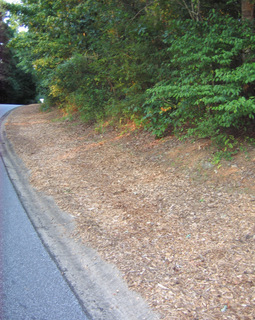Green Brown Lawn
Air Date: Week of July 31, 2009

Writer Pat Priest
Writer Pat Priest of Athens, Georgia isn't interested in keeping up with the Joneses. In fact, while her neighbor is busy tending to his sodded lawn, Priest has been undoing her grass, and putting down layers of recycled paper and mulch.
Transcript
YOUNG: As they say the grass is always greener on the other side, but commentator Pat Priest of Athens Georgia prefers what’s on her side of the fence.
PRIEST: My name was drawn at a raffle recently, and I learned I'd won a free month of tanning! As a teenager I would have been thrilled, but . . . now . . . in my fifties? I know better! I felt awkward turning it down, but then other people passed on it, too! We've learned to just say no to a cigarette, veal . . . and tanning.

The green grass of Pat Priest's driveway before it was overturned.
A half-acre needs tens of thousands of gallons of water yearly. But the problems are more deeply rooted than simply conserving water. Perfect grass really is much like the perfect tan, which may look like a sign of robust health but more often is evidence of damaging practices.
The green, green grass of home is usually the result of pesticides and herbicides that kill creatures in nearby streams when storm water flushes out the toxins.
Fertilizers also damage aquatic environments and the mining of phosphate rock for fertilizer has poisoned the water in places as far flung as Idaho and Florida.
And what would ancient cultures think and those in the future for that matter, to see us walking around in circles mowing grass?
The Environmental Protection Agency estimates that lawn mowers use 800 million gallons of gas each year. And the emissions cause five percent of the air pollution in the US.

The brown, mulched lawn requires no water or chemicals.
We covered the paper with mulch made from invasive species such as privet and Russian olive. These layers will improve our hard clay soil. When it’s cooler, I’ll put in lots of native plants. They’re like a big “Welcome” sign for pollinators and other species whose habitat is disappearing.
To undo my lawn yard by yard was as labor intensive initially as my neighbor's sod laying. But I don’t need to mow or use chemicals now that I'm finished. My yard doesn’t look like a golf course, but it’s a safe haven for my family, dogs, and wildlife.
By undoing my lawn, I’m overturning convention and commonly held aesthetics to stave off the unraveling of the irreplaceable web of life on Earth.
[MUSIC: Robyn Hitchcock “Chinese Water Python” from Eye (Yep Roc Records 2007)]
YOUNG: Writer Pat Priest tends her brown lawn in Athens Georgia.
Living on Earth wants to hear from you!
Living on Earth
62 Calef Highway, Suite 212
Lee, NH 03861
Telephone: 617-287-4121
E-mail: comments@loe.org
Newsletter [Click here]
Donate to Living on Earth!
Living on Earth is an independent media program and relies entirely on contributions from listeners and institutions supporting public service. Please donate now to preserve an independent environmental voice.
NewsletterLiving on Earth offers a weekly delivery of the show's rundown to your mailbox. Sign up for our newsletter today!
 Sailors For The Sea: Be the change you want to sea.
Sailors For The Sea: Be the change you want to sea.
 The Grantham Foundation for the Protection of the Environment: Committed to protecting and improving the health of the global environment.
The Grantham Foundation for the Protection of the Environment: Committed to protecting and improving the health of the global environment.
 Contribute to Living on Earth and receive, as our gift to you, an archival print of one of Mark Seth Lender's extraordinary wildlife photographs. Follow the link to see Mark's current collection of photographs.
Contribute to Living on Earth and receive, as our gift to you, an archival print of one of Mark Seth Lender's extraordinary wildlife photographs. Follow the link to see Mark's current collection of photographs.
 Buy a signed copy of Mark Seth Lender's book Smeagull the Seagull & support Living on Earth
Buy a signed copy of Mark Seth Lender's book Smeagull the Seagull & support Living on Earth

